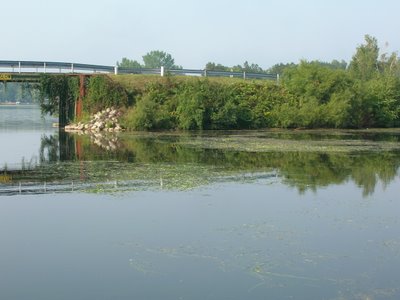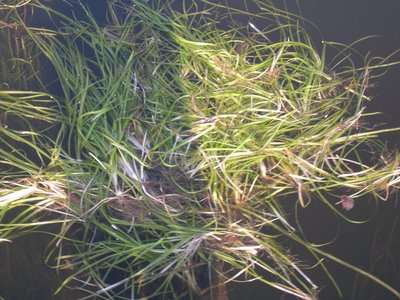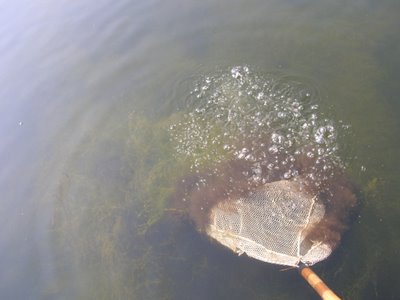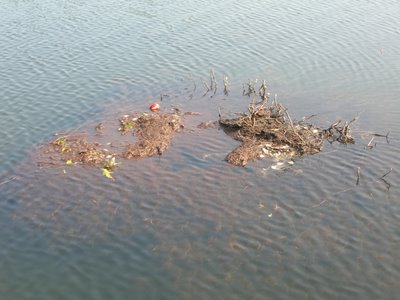Summit Labs Canadian Lakes Management
The Summit Labs Canadian Lake Management Blog was created to provide Canadian Lake Riparian owners better access to us, their lake managers. Communication is essential in successful lake management. Efficient communication allows us to maximize our time managing while satisfying riparians questions and concerns.
Friday, September 22, 2006
What’s the Story with Wild Celery?
Was it the relatively mild weather? Was it competition from other native aquatic plants? Was it predation from hungry animals like ducks and muskrats? Was it the ecological shift following the general herbicide treatment? Whatever it was that kept the Vallisneria reproductive “curly-q” shoots from coming in as dense as they have in past years, it didn’t in 2006.
The “curly q” reproductive shoots may have caused you some minor nuisance issues, as the plant loves to colonize under docks and raked beaches. A good lake rake will solve the problem in 10 minutes and will have to be used in these isolated cases. Contiguous dense patches receive algaecide treatment, they just weren’t present this season. Not having to use copper algaecide translates not only to financial savings but also ecological savings as non-target fish insects and beneficial plants are not adversely affected.
Vallisneria did create some nuisance issues in East Lake. The uprooted adult plants are clustered together near the entrances to East Lake. Boats, birds and mammals uprooted these plants. Treating these mats with herbicide/algaecide is not only ineffective, but may lead to future ecological disturbances that would require an ever-increasing amount of herbicide. In the Blog we have discussed how critical it is to limit in-lake nutrients if you truly want to minimize nuisance aquatic vegetation. ”If you feed them, they will grow (1lb of phosphorus gives rise to 500 or more lbs of aquatic plants and algae).” The higher in-lake nutrient levels become, the more potential for plant biomass. For the past many years and for the foreseeable many years, we will be using contact herbicides to singe down native plants that are creating a nuisance. This releases nutrients that then become available to prolific ate other aquatic organisms such as algae and aquatic vascular plants. The general herbicide treatment in June shifts the biomass away from spring emergent like Illinois Pondweed and Northern Milfoil. The nutrients released are then taken up by algae or remain in the water column waiting to be used by late season emergent like Wild Celery. You can see how overtime Wild Celery will be favored. For that reason, we were prepared to administer a criteria based site-specific copper algaecide treatment to dense patches of Wild Celery. These patches send up the “curly-q’s” that drive everyone crazy. We continue to explore the possibility of adding an aquatic vegetation harvester to our tool bag. Having access to a harvester would allow us to remove the mats witnessed around the East Lake entrances late this season. It is important to state that a harvester would not be a cure all to our aquatic vegetation management needs. They are slow and expensive to operate. A harvester would never be able to replace the use of herbicides in CL but would allow a much higher level of aquatic nuisance control without significant ecological damage.
A New Island for Far West?
Something is floating at the water surface just south of the smaller island in Far West.
What is it? Organic matter (peat) that became submerged under the water during or before the creation of the lakes. As this organic matter slowly decomposes (as oxygen and temperature allow). The gases released during this decomposition process can become trapped in the peat. Under these conditions the peat can become less dense than the water and “lift” to the surface. The process is similar to filling a hot air balloon.
At the surface, wind and boat wave action can liberate or shake the gases loose from the floating peat island causing it to sink back to the bottom. The chunk of peat at the surface in Far West is only a few feet across. This scenario has been playing out in East Lake for years with two larger peat islands. A loon nested on the smaller peat island this year. This same island may be submerged next year. The larger floating East Lake peat island (just North of the marina) blew along shore this spring. It was pulled on shore and removed just recently. The piles of rich organic peat are excellent for supplementing nutrients in garden soils. If you do use some in your garden remember the organic matter may be slightly acidic and it must be mixed with sandy or loamy soils to ensure proper drainage.
What is going to be done about the floating peat in Far West? Because of its small size, location (the center of a “No Wake” lake) and the fact that it appears to still be attached to the bottom this late in the season, we can allow Mother Nature to solve this problem on her own. If this chunk of peat has not already settled back to the bottom before ice cover, it will very likely settle down due to the ice cover. We shouldn’t see it next spring but we’ll keep our eyes peeled as always.





